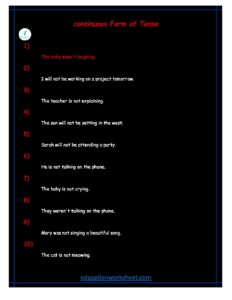how to converting continuous tense interrogative sentences to positive form
how to converting continuous tense interrogative sentences to positive form
Understanding Continuous Tenses:
Before we delve into the transformation process, it’s crucial to have a clear understanding of continuous tenses. English has three continuous tenses:
-
- Present Continuous (also known as Present Progressive)
- Past Continuous (also known as Past Progressive)
- Future Continuous
Present Continuous to Positive Form:

- To convert a present continuous interrogative sentence into a positive form, follow these steps:
- Remove the question word.
- Swap the subject and the auxiliary verb.
- Change the main verb to its base form.
- Add “is,” “am,” or “are” as the auxiliary verb, depending on the subject.
Example:
- Interrogative: Is she eating dinner?
- Positive: She is eating dinner.Past Continuous to Positive Form:
- To convert a past continuous interrogative sentence into a positive form:
- Remove the question word.
- Swap the subject and the auxiliary verb.
- Change the main verb to its base form.
- Add “was” as the auxiliary verb for singular subjects or “were” for plural subjects.
Example:
- Interrogative: Were they studying yesterday?
- Positive: They were studying yesterday.
Future Continuous to Positive Form:

- To convert a future continuous interrogative sentence into a positive form, use the following steps:
- Remove the question word.
- Swap the subject and the modal auxiliary “will be.”
- Change the main verb to its base form.
Example:
- Interrogative: Will you be working late tomorrow?
- Positive: You will be working late tomorrow.Handling Modal Auxiliaries:
In some cases, questions might contain modal auxiliaries like “can,” “should,” “must,” etc. When converting these to positive sentences, you maintain the modal auxiliary while modifying the structure.
Example:
Interrogative: Can she be coming to the party?
- Positive: She can be coming to the party.Adverbial Phrases:
Be mindful of any adverbial phrases or elements in the original interrogative sentence, such as “right now,” “at the moment,” or “next week.” Ensure they are correctly placed in the positive form.
Example:
- Interrogative: Is he playing football right now?
- Positive: He is playing football right now.Subject-Verb Agreement: Pay attention to subject-verb agreement when changing the auxiliary verb. For singular subjects, use “is” or “was,” and for plural subjects, use “are” or “were.”
Example:
- Interrogative: Are the children watching TV?
- Positive: The children are watching TV.Adding Context: In positive sentences, it can be helpful to add context or additional information to make the statement more complete. This could include time, place, or other relevant details.
Example:
- Interrogative: Are they studying?
- Positive with context: They are studying at the library.Verb Conjugation: Ensure the main verb is correctly conjugated based on the subject and tense. For example, use “eat” for “I” and “he/she/it” in the present continuous tense and “ate” for “I” and “he/she/it” in the past continuous tense.
- Punctuation: Remember to include the appropriate punctuation at the end of the positive sentence. For declarative sentences, use a period (full stop).
how to converting continuous tense interrogative sentences to positive form

Example:
- Interrogative: Is he playing tennis?
- Positive: He is playing tennis.
In conclusion, converting continuous tense interrogative sentences to positive form involves a few essential steps, including changing the word order, modifying the auxiliary verb, and ensuring subject-verb agreement. It’s crucial to understand the specific rules for each continuous tense and practice this skill to become proficient at transforming questions into positive statements. With time and practice, you’ll find this process to be increasingly intuitive and a valuable aspect of your English language skills.

